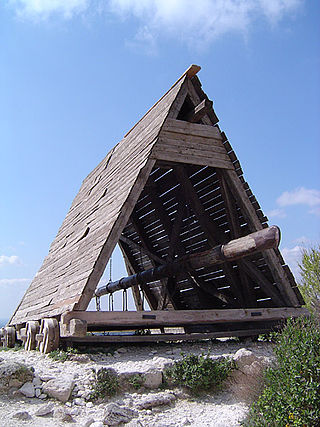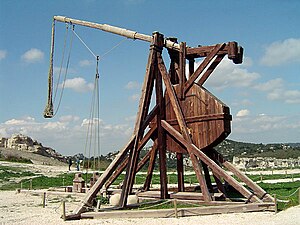
A catapult is a ballistic device used to launch a projectile a great distance without the aid of gunpowder or other propellants – particularly various types of ancient and medieval siege engines. A catapult uses the sudden release of stored potential energy to propel its payload. Most convert tension or torsion energy that was more slowly and manually built up within the device before release, via springs, bows, twisted rope, elastic, or any of numerous other materials and mechanisms.

Medieval fortification refers to medieval military methods that cover the development of fortification construction and use in Europe, roughly from the fall of the Western Roman Empire to the Renaissance. During this millennium, fortifications changed warfare, and in turn were modified to suit new tactics, weapons and siege techniques.

The ballista, plural ballistae, sometimes called bolt thrower, was an ancient missile weapon that launched either bolts or stones at a distant target.

A trebuchet is a type of catapult that uses a rotating arm with a sling attached to the tip to launch a projectile. It was a common powerful siege engine until the advent of gunpowder. The design of a trebuchet allows it to launch projectiles of greater weights and further distances than that of a traditional catapult.

A castle is a type of fortified structure built during the Middle Ages predominantly by the nobility or royalty and by military orders. Scholars usually consider a castle to be the private fortified residence of a lord or noble. This is distinct from a mansion, palace and villa, whose main purpose was exclusively for pleasance and are not primarily fortresses but may be fortified. Use of the term has varied over time and, sometimes, has also been applied to structures such as hill forts and 19th- and 20th-century homes built to resemble castles. Over the Middle Ages, when genuine castles were built, they took on a great many forms with many different features, although some, such as curtain walls, arrowslits, and portcullises, were commonplace.
The Battle of Xiangyang was a protracted series of battles between the Yuan dynasty and the Southern Song dynasty from 1267 to 1273. The battle was a significant victory for the Yuan dynasty and ended a 30-year defensive campaign waged by the Southern Song dynasty, allowing Yuan forces to advance into the Southern Song heartland. The capture of Xiangyang also allowed the Yuan dynasty to take control of the Han and Yangtze rivers, thereby depriving the Southern Song dynasty of two formidable natural barriers. The defeat devastated the Southern Song dynasty, which collapsed several years later at the Battle of Yamen.

A defensive wall is a fortification usually used to protect a city, town or other settlement from potential aggressors. The walls can range from simple palisades or earthworks to extensive military fortifications with towers, bastions and gates for access to the city. From ancient to modern times, they were used to enclose settlements. Generally, these are referred to as city walls or town walls, although there were also walls, such as the Great Wall of China, Walls of Benin, Hadrian's Wall, Anastasian Wall, and the Atlantic Wall, which extended far beyond the borders of a city and were used to enclose regions or mark territorial boundaries. In mountainous terrain, defensive walls such as letzis were used in combination with castles to seal valleys from potential attack. Beyond their defensive utility, many walls also had important symbolic functions – representing the status and independence of the communities they embraced.

The mangonel, also called the traction trebuchet, was a type of trebuchet used in Ancient China starting from the Warring States period, and later across Eurasia by the 6th century AD. Unlike the later counterweight trebuchet, the mangonel operated on manpower-pulling cords attached to a lever and sling to launch projectiles.

A siege engine is a device that is designed to break or circumvent heavy castle doors, thick city walls and other fortifications in siege warfare. Some are immobile, constructed in place to attack enemy fortifications from a distance, while others have wheels to enable advancing up to the enemy fortification. There are many distinct types, such as siege towers that allow foot soldiers to scale walls and attack the defenders, battering rams that damage walls or gates, and large ranged weapons that attack from a distance by launching projectiles. Some complex siege engines were combinations of these types.

The onager was a Roman torsion powered siege engine. It is commonly depicted as a catapult with a bowl, bucket, or sling at the end of its throwing arm. The onager was first mentioned in 353 AD by Ammianus Marcellinus, who described onagers as the same as a scorpion. The onager is often confused with the later mangonel, a "traction trebuchet" that replaced torsion powered siege engines in the 6th century AD.

Early thermal weapons, which used heat or burning action to destroy or damage enemy personnel, fortifications or territories, were employed in warfare during the classical and medieval periods.

A ranged weapon is any weapon that can engage targets beyond hand-to-hand distance, i.e. at distances greater than the physical reach of the user holding the weapon itself. The act of using such a weapon is also known as shooting. It is sometimes also called projectile weapon or missile weapon because it typically works by launching solid projectiles ("missiles"), though technically a fluid-projector and a directed-energy weapon are also ranged weapons. In contrast, a weapon intended to be used in hand-to-hand combat is called a melee weapon.
Roman siege engines were, for the most part, adapted from Hellenistic siege technology. Relatively small efforts were made to develop the technology; however, the Romans brought an unrelentingly aggressive style to siege warfare that brought them repeated success. Up to the first century BC, the Romans utilized siege weapons only as required and relied for the most part on ladders, towers and rams to assault a fortified town. Ballistae were also employed, but held no permanent place within a legion's roster, until later in the republic, and were used sparingly. Julius Caesar took great interest in the integration of advanced siege engines, organizing their use for optimal battlefield efficiency.

A springald, or espringal, was a medieval torsion artillery device for throwing bolts. It is depicted in a diagram in an 11th-century Byzantine manuscript, but in Western Europe is more evident in the late 12th century and early 13th century. It was constructed on the same principles as an Ancient Greek or Roman ballista, but with inward swinging arms and threw bolts instead of stones. It was also known as a 'skein-bow', and was a torsion device using twisted skeins of silk or sinew to power two bow-arms.

Bedford Castle was a large medieval castle in Bedford, England. Built after 1100 by Henry I, the castle played a prominent part in both the civil war of the Anarchy and the First Barons' War. The castle was significantly extended in stone, although the final plan of the castle remains uncertain. Henry III of England besieged the castle in 1224 following a disagreement with Falkes de Bréauté; the siege lasted eight weeks and involved an army of as many as 2,700 soldiers with equipment drawn from across England. After the surrender of the castle, the king ordered its destruction (slighting).

Chinese city walls refer to defensive walls built to protect important towns and cities in pre-modern China. In addition to walls, Chinese city defenses also included fortified towers and gates, as well as moats and ramparts around the walls.

A torsion siege engine is a type of siege engine that utilizes torsion to launch projectiles. They were initially developed by the ancient Macedonians, specifically Philip II of Macedon and Alexander the Great, and used through the Middle Ages until the development of gunpowder artillery in the 14th century rendered them mostly obsolete.

This is an overview of Chinese siege weapons.
The siege of Tortosa was a military campaign by King Louis the Pious of Aquitaine in 808–809. It was part of a decade of intense activity by Louis against the Umayyad Emirate in the region of the lower Ebro. The chronology of his campaigns, which must be worked out from both Latin and Arabic sources, is subject to different interpretations.

The torsion mangonel myth, or simply the myth of the mangonel, is the belief that mangonels were torsion siege engines such as the ballista or onager which used the tension effect of twisted cords to shoot projectiles. Despite a significant body of research dating as far back as the 19th century pointing to the contrary, "it has not stopped the transmission of the myth to the present day." Evidence for the usage of torsion siege weapons, with the exception of the springald, exist only up until the 6th century, when they were superseded by the traction trebuchet, more commonly known as the mangonel.
















